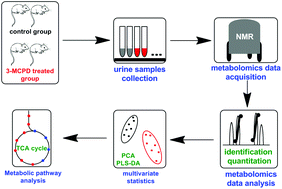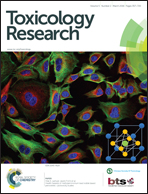1H NMR-based urine metabolomics for the evaluation of kidney injury in Wistar rats by 3-MCPD†
Abstract
The cause of toxicity induced by 3-chloro-1,2-propanediol (3-MCPD) remains under investigation, and progress towards understanding this toxicity has been limited by the lack of sensitive and reliable biomarkers. Global metabolomics were analyzed to characterize the phenotypical biochemical perturbations and potential mechanisms of the 3-MCPD-induced toxicity. 3-MCPD was administered to Wistar rats (60 mg per kg bw, oral) for 7, 21, and 35 days and urine samples were collected at each time point. The urinary metabolomics was performed by 1H NMR, and the NMR spectrum signals of the detected metabolites were normalized and analyzed by orthogonal pattern recognition methods (PCA and OPLS-DA). This analysis revealed a time- and dose-dependency of the biochemical perturbations induced by 3-MCPD toxicity. Several metabolites responsible for glycine, serine and threonine metabolism, taurine and hypotaurine metabolism and nicotinate and nicotinamide metabolism revealed that 3-MCPD produced serious kidney toxicity, consistent with clinical biochemistry and histopathology. Significant changes in seven identified metabolites were validated as phenotypic biomarkers of 3-MCPD toxicity. Overall, our work demonstrates the powerful use of metabolomics for improved detection of toxicity and biomarker discovery and highlights the powerful predictive potential of such analyses for understanding food toxicity.


 Please wait while we load your content...
Please wait while we load your content...